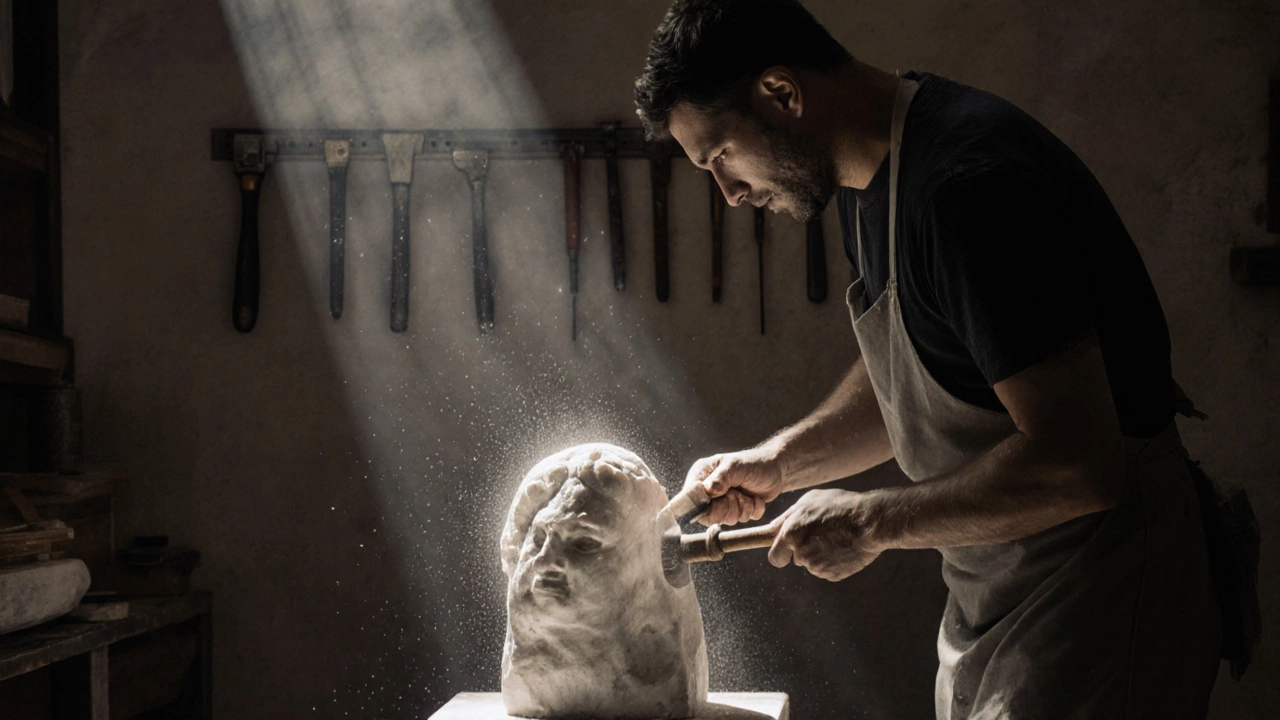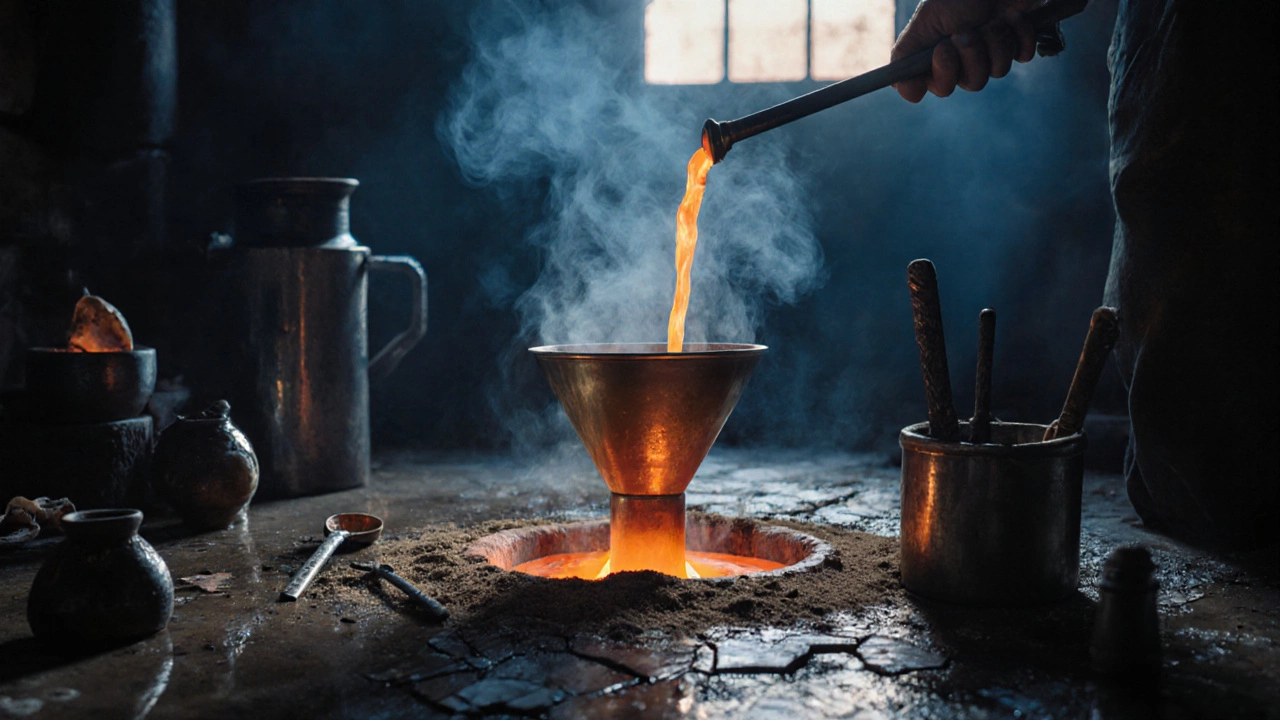Sculpting Methods Comparison Tool
Compare the four fundamental sculpting techniques and see which might be best for your next project.
Key Attributes
| Method | Materials | Difficulty | Time | Cost | Best For | Modern Adaptation |
|---|---|---|---|---|---|---|
| Additive | Clay, wax, plaster, wire | Easy | Moderate | Low | Small to medium works, character design | 3D printing |
| Subtractive | Stone, wood, foam | Hard | Long | High | Public monuments, detailed stone works | Laser cutting |
| Modeling | Clay (primary) | Easy | Variable | Low | Small sculptures, animation figures | Digital sculpting |
| Casting | Wax, bronze, plaster | Hard | Very Long | Very High | Replication, permanent pieces | Resin casting |
When you think of sculpture, you might picture a marble statue or a bronze figure in a park. But behind every piece of sculpture is a process-four basic methods that artists have used for thousands of years, and still rely on today. Whether you're a beginner trying your hand at clay or a seasoned artist working in metal, understanding these core techniques is essential. These aren't just historical footnotes-they're living practices that shape how art is made, from small studio pieces to public monuments.
Additive Sculpting: Building Up
Additive sculpting is exactly what it sounds like: you build the form by adding material. This is the most intuitive method for beginners because it’s like playing with play-dough, but with far more serious results. Artists use clay, wax, plaster, or even wire and found objects to gradually construct a shape. The beauty of additive sculpting is that you can change your mind as you go. If a limb looks too thin, you add more clay. If the pose feels off, you reshape it. No mistakes are permanent-until you fire or cast it.
Many contemporary sculptors start with wire armatures to give structure, then wrap them in clay or polymer. This method is common in character design for animation and film, where quick iterations matter. The famous sculptor Auguste Rodin used additive techniques in his early studies, building up figures in clay before committing to bronze. Today, 3D printing has taken additive sculpting further-artists now digitally model forms and print them in resin or metal, but the core idea remains the same: start with nothing and build upward.
Subtractive Sculpting: Carving Away
Subtractive sculpting is the opposite: you start with a solid block and remove material until the form emerges. This is the method most people associate with classical sculpture-chiseling away at marble or wood. It demands patience, precision, and a deep understanding of the material’s grain and strength. One wrong strike can ruin weeks of work.
Michelangelo famously said he saw the figure already inside the marble and just freed it. That’s the mindset of subtractive sculpting. You don’t imagine the shape-you discover it. This method works best with hard materials: stone, hardwood, ice, or even foam blocks for temporary installations. Stone carving, especially in marble and limestone, requires chisels, mallets, rasps, and sandpaper. Wood carving uses gouges and knives, and the grain direction matters-carving with the grain prevents splitting.
Many artists today still carve stone, not just for tradition, but because the texture and permanence of stone give weight and presence that other materials can’t replicate. A single block of Carrara marble can become a lifelike portrait or an abstract form that feels timeless.

Modeling: Shaping Soft Materials
Modeling is a subtype of additive sculpting, but it’s worth calling out separately because of how widely it’s used and how different it feels from other methods. Modeling means working with soft, pliable materials-most commonly clay, but also wax, polymer, or even dough. The key difference from general additive sculpting is that modeling is often done on a smaller scale and with finer control. It’s the method used in ceramics, figurines, and pre-cast sculptures.
Clay modeling is the foundation of most sculpting education. You learn to pinch, coil, slab, and smooth. The material stays workable until it’s dried or fired. Many artists make detailed models in clay before casting them in bronze or plaster. This is called the lost-wax process, which we’ll get to in a moment. Modeling lets you capture texture: fingerprints, fabric folds, wrinkles-things that feel alive. It’s also the go-to method for stop-motion animation figures, where every subtle movement needs to be sculpted by hand.
Unlike carving, where you’re limited by the size of your block, modeling lets you scale freely. You can make a tiny hand or a full-size torso with the same tools. And because clay can be reused, it’s forgiving. You can reshape, rework, and rebuild without waste.

Casting: Making Multiples
Casting isn’t about shaping the material directly-it’s about pouring liquid into a mold to create a copy. This is the only method that allows you to make multiple identical pieces. It’s how bronze statues multiply, how resin ornaments are mass-produced, and how artists preserve a single clay model into a durable, permanent form.
The most common casting method in fine art is lost-wax bronze casting. It starts with a clay or wax model. That model is covered in a heat-resistant mold material. Then, the wax is melted out (hence, "lost-wax"). Molten bronze is poured into the empty space. Once cooled, the mold is broken away, revealing the sculpture. The process takes weeks, requires a foundry, and costs thousands-but the result is a strong, detailed, and enduring piece.
Other casting materials include plaster, resin, silicone, and even concrete. Plaster casting is common for making molds from life casts-like a face or hand taken from a person. Resin casting is popular in modern art for its clarity and ability to hold fine details, especially when mixed with pigments or embedded objects. Casting lets artists turn something temporary into something eternal.
Why These Four Methods Still Matter
Technology has changed how we make art, but it hasn’t replaced these four methods. 3D printers do additive sculpting faster. Laser cutters can carve wood or acrylic. But none of them replace the artist’s hand, the feel of clay between fingers, the sound of a chisel hitting stone, or the anticipation of pouring molten metal.
These methods aren’t just techniques-they’re philosophies. Additive sculpting is about creation from nothing. Subtractive sculpting is about revelation through discipline. Modeling is about intimacy and detail. Casting is about legacy and replication.
Most professional sculptors use more than one method. A single piece might start as a clay model (modeling), then be cast in bronze (casting), with final details added by hand (subtractive carving). The best artists don’t stick to one-they move fluidly between them, choosing the method that best serves the idea.
If you’re new to sculpture, start with modeling in clay. It’s affordable, accessible, and teaches you form, balance, and texture. Once you understand how material behaves, you can explore carving, additive construction, or even find a local foundry to try casting. Each method opens a different door. And once you walk through one, you’ll see the others in a whole new light.
Can you combine sculpting methods in one artwork?
Yes, combining methods is common and often necessary for complex pieces. Many artists begin with clay modeling to shape the form, then cast it in bronze, and finally carve or file details by hand. Some add welded metal elements to a carved wooden base. The four methods aren’t strict rules-they’re tools. The best sculptors use whatever combination serves the vision.
Which sculpting method is easiest for beginners?
Modeling with clay is the easiest for beginners. It’s forgiving, inexpensive, and doesn’t require special tools beyond your hands and a few simple implements. You can start with air-dry clay from a craft store and work on a kitchen table. Unlike carving, you can’t ruin a block by mistake. Unlike casting, you don’t need a foundry. It’s the most direct way to learn form and texture.
Is casting only for bronze sculptures?
No, casting works with many materials. Bronze is the most famous in fine art, but plaster is used for molds and replicas, resin for transparent or colorful pieces, silicone for flexible forms, and even concrete for large outdoor installations. The process is the same: make a mold, pour the material, let it set. The material choice depends on the look, durability, and budget.
Why do sculptors still carve stone when it’s so hard and expensive?
Stone has qualities no other material fully replicates: density, permanence, and a natural beauty that changes with light. A carved stone piece feels grounded, ancient, and weighty. Even with modern tools, the process connects the artist to centuries of tradition. Many sculptors choose stone not because it’s easy, but because the challenge adds meaning. The slow, physical act of carving becomes part of the artwork’s story.
Can you do sculpting without expensive tools or a studio?
Absolutely. You can model with clay on a tabletop, carve soap or foam with a butter knife, or assemble forms from wire and paper. Many street artists build sculptures from scrap metal or reclaimed wood. The tools matter less than the intention. Some of the most powerful sculptures are made from simple materials and found objects. Start with what you have-your hands, some clay, or a block of styrofoam-and learn by doing.

